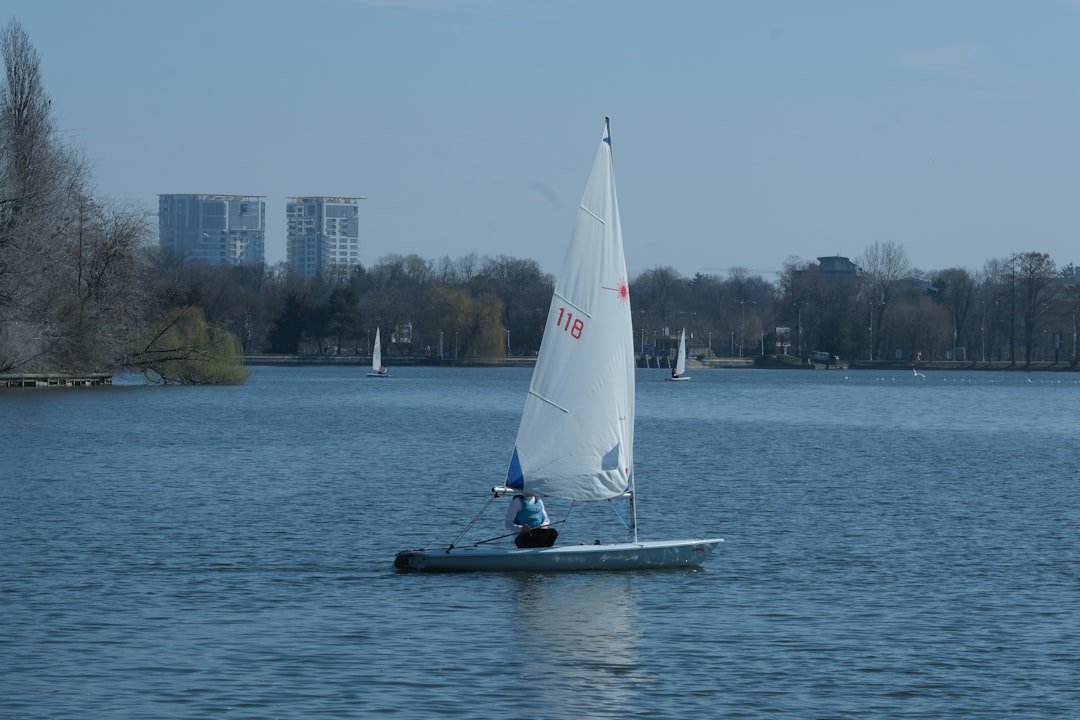

Engage prospects with a scan and streamline customer engagement with FREE QR code marketing tools by Sona – no strings attached!
Create a Free QR CodeFree consultation

No commitment

Engage prospects with a scan and streamline customer engagement with FREE QR code marketing tools by Sona – no strings attached!
Create a Free QR CodeFree consultation

No commitment
Sailing schools are navigating a new era in which collecting actionable student feedback is a core component for improving courses, refining safety protocols, and delivering exceptional participant experiences. Yet, many schools still grapple with outdated processes such as paper forms, slow post-course surveys, and fragmented record keeping. These analog methods often result in missed high-value feedback, delayed insights, and, ultimately, a sluggish response to operational challenges and evolving customer expectations.
A significant portion of valuable student perspectives never make it into any system at all, especially when students are on the move or engaged in practical lessons outdoors. Modern, tech-forward sailing schools are turning to digital solutions that make real-time input collection easier, less intrusive, and more actionable. QR codes in education enable schools to bridge the gap between hands-on training and prompt, high-quality digital feedback.
This guide shows how sailing schools can leverage QR codes to obtain authentic, timely feedback and how doing so can reveal hidden issues, support continuous improvement, mitigate the risk of operational blind spots, and deepen student loyalty, all while meeting high standards for safety, inclusivity, and compliance in a competitive landscape.

For many sailing schools, a persistent pain point is the number of student experiences and potential issues that go unreported simply because feedback collection feels cumbersome or inconvenient. This often leads to a lack of visibility into pressing student concerns, delayed identification of safety gaps, and missed opportunities to improve the curriculum. QR codes solve the convenience problem by making feedback entry points highly visible and scannable at the moments when students and instructors are most likely to share honest reflections.
Modern approaches address these shortcomings by embedding scannable QR codes at critical touchpoints: on course certificates, in lesson notebooks, at the end of online modules, on boarding docks, and on boats. By making feedback forms instantly accessible, whether after a course, during a safety briefing, or before equipment return, schools remove friction and invite participation within seconds. Benchmarking metrics such as survey completion rate and net promoter score before and after QR rollout helps quantify impact and justify continued investment.
To maximize results, replace analog processes with QR-enabled workflows. Paper surveys become mobile-optimized forms that load in under two seconds. Manual sign-up sheets for advanced courses become self-serve QR journeys that capture intent and route students to the right course counselor. Notices on bulletin boards become interactive digital signage that log scans by location and time, creating a heatmap of engagement across your facility. Platforms like Sona QR streamline code creation, routing, and analytics, so operational teams can optimize placement, messaging, and timing without reprinting anything.

Sailing education operates in fast-paced, outdoor environments where traditional feedback methods are inconvenient and easy to ignore. Many schools face the dual frustration of low response rates and shallow feedback. As a result, valuable signals for course improvement, safety, and retention remain hidden. Opportunities to engage alumni or promote advanced certifications are also missed when forms sit in a drawer or emails go unopened.
QR codes overcome these hurdles by making it easy for every student to provide immediate input, no matter where they are. When deployed at the point of experience, QR codes encourage real-time engagement: students can submit a quick reflection right after docking, request an advanced class on the ride home, or report a minor safety incident before it escalates. Since QR codes are universally scannable with a phone camera, there is no app to download and no account to create.
Another advantage is agility. A dynamic QR system allows schools to update destinations without reprinting materials. If standards such as the ABYC curriculum update safety requirements or a school revises curriculum, the linked forms can be edited immediately while the physical code stays in place. Built-in analytics provide a real-time view of participation by location, course, and instructor. A sudden dip in scans at a specific dock or classroom may indicate signage problems or disengagement. Leadership can then respond quickly with a sign refresh, staff coaching, or a revised call to action.
QR-enabled feedback also supports compliance and storytelling. Testimonials can be captured with consent for marketing. Usage statistics help demonstrate commitment to continuous improvement during recertification processes. Safety reports, near misses, and resolution notes can be logged and linked to training updates, creating a traceable record that shows regulators and insurers a robust safety culture.

Just as no two sailing courses are the same, feedback channels should be tailored to different goals and audiences. The challenge is capturing nuanced feedback from students, parents, instructors, and alumni without overwhelming staff. The right mix of QR formats helps create a smooth, context-aware experience while keeping administration manageable.
Dynamic QR codes managed in a centralized platform such as Sona QR allow effortless updating as lessons evolve, seasonal schedules shift, or new cohorts arrive. This avoids the pain of outdated forms, dead links, or misdirected feedback. Use static codes for unchanging destinations like a PDF syllabus and dynamic codes for any destination that might change or require tracking and attribution.
It is easy to miss valuable opportunities for student engagement when feedback is disconnected from natural points of contact. Some schools struggle to identify where student sentiment is strongest or where risk factors are highest, which leads to underutilized data and slower improvements. Placing QR codes in the right locations turns everyday surfaces into reliable feedback channels.
Strategic deployment targets moments when students and instructors are most likely to provide candid input. These include the end of a practical lesson while the experience is vivid, safety briefings when attention to detail is high, certificate handoffs when pride is high, and gear returns when equipment issues are top-of-mind. By aligning collection with these high-engagement moments, schools foster higher participation and quickly identify which courses, instructors, or environments need attention.
Careful testing of placement and copy is key. Start with multiple variants across the campus, monitor scan patterns, then standardize the formats that attract the most engagement. Sona QR’s use case library lets you tag codes by location and campaign so you can compare classroom signage versus on-boat decals and adjust strategy based on real performance.

Feedback gaps can undermine operational excellence and erode brand reputation. Sailing schools that embrace QR codes have produced consistent value in several high-impact scenarios. The most effective use cases share a common thread: they meet the student exactly where they are and route data to the right team member or system instantly.
These use cases can be tailored to different audiences such as youth programs, adult learners, corporate team-building groups, and regatta participants. A flexible form builder and dynamic routing help ensure each audience sees the right questions and the right next step.
An ongoing challenge in sailing schools is the inability to segment audiences accurately after initial engagement. Without knowing who scanned which code, follow-up campaigns become generic and less effective, which means schools fail to capitalize on student interest or willingness to advance their learning. QR codes, when uniquely assigned to course levels, locations, or events, turn each scan into a reliable intent signal that can feed segmented follow-up.
By assigning unique QR codes to various course levels, events, and alumni groups, schools can transform fragmented signals into structured audiences. Sona QR can automatically sync these segments to your CRM or email platform and can trigger workflows such as “Invite student to Advanced Keelboat” or “Send post-regatta thank you.” With consent, you can tie scans to known contacts and build lifecycle journeys that reflect real behavior rather than assumptions, and use them for intent-driven retargeting.
Each scan can record time, location, and device, helping you distinguish campus visitors from off-site respondents. These distinctions improve the quality of retargeting and help you test messaging by segment. Dynamic links also allow you to swap destinations for different stages of the season without changing the printed code.
Disconnected campaigns are a common source of wasted spend and missed growth for sailing schools. Print ads, event banners, and digital communications often fail to reflect real student progress or connect with each other. QR codes unify these touchpoints by mapping prospect and student journeys so that marketing, instruction, and alumni engagement are aligned from first scan to long-term loyalty.
When QR codes are added to your marketing assets, each physical item becomes measurable. You can see which brochures drive enrollments, which docks produce the most feedback, and which event banners generate the most testimonials. A centralized platform like Sona QR pulls these signals into a single view and syncs them to your CRM, making follow-up both personal and timely.
Use consistent design cues across channels to build recognition. A simple frame around the code, a short benefit-driven caption, and your school’s colors help students trust the link and understand what they will get by scanning. For connecting offline scans to outcomes, see Sona’s blog on offline attribution.
Clarity and process are often missing from feedback initiatives, which leads to inconsistent rollouts and patchy results. A structured approach helps teams deploy QR codes with confidence and standardize best practices across locations and cohorts. The following steps reflect how top sailing schools plan, launch, and continuously improve their QR programs.
This checklist covers goal setting, code selection, design and testing, deployment, and analytics. It is designed for operations leaders, program directors, and marketing managers who want to replace paper forms and manual follow-up with instant, measurable workflows. The same structure works for feedback, safety, enrollment interest, and alumni engagement.

A persistent pain point in feedback initiatives is the inability to attribute improvements to specific student interactions. Schools may see higher feedback counts without clarity on where those signals came from or how they influenced decisions. Advanced QR analytics close this gap by tying scans to context, outcomes, and follow-up actions in one unified view.
With Sona QR and Sona.com, schools can capture the full arc of engagement: who scanned, when and where they scanned, what device they used, whether they completed a form, and how that data influenced operations or marketing. This enables a clear connection between real-world engagement and outcomes such as higher retention, fewer incidents, and more referrals.
A closed-loop approach ensures that increased feedback volume translates into better decisions. Publish monthly dashboards for staff, recognize instructors who drive high satisfaction, and share top improvements with students so they see the value of participating.
Continuous improvement depends on broad adoption and creative implementation. Many schools find that simple tweaks such as unique codes per class, clear calls to action, or automated follow-up make a significant difference in both feedback quantity and quality. The following tips work well in sailing environments where surfaces are exposed to water, sun, and movement.
Start by standardizing design templates and instructor scripts. Then pilot creative deployments that bring the feedback loop closer to the moment of learning. Use incentives sparingly and focus on speed, clarity, and relevance. The faster a form loads and the clearer the benefit, the more likely students are to scan and respond.
As your program matures, share success stories widely. Show how feedback led to improved teaching techniques, new safety protocols, or better equipment maintenance. Visible impact builds trust and boosts participation over time.
Historically, feedback has been a weak link in sailing school operations, with critical signals buried in stacks of paper or lost to follow-up fatigue. QR codes are reshaping this paradigm by making it natural for every student, instructor, or parent to influence real improvements. When QR-enabled surveys and analytics are embedded throughout the student journey, schools capture a wider range of insights and develop a culture of continuous learning, safety, and community.
By embracing QR-enabled feedback systems and centralized analytics, sailing schools can finally bridge the gap between hands-on instruction and actionable digital insight. This approach uncovers pain points and growth opportunities missed by traditional methods, supports a dynamic and responsive operational model, and demonstrates a commitment to inclusivity and safety. As the industry evolves, programs that treat feedback as a daily, embedded practice will see stronger retention, more referrals, and a safer, more vibrant sailing community. With tools like Sona QR and Sona, you can launch quickly, measure what matters, and prove the impact of every scan.
QR codes have revolutionized sailing schools by transforming traditional feedback collection into a seamless, interactive experience that drives continuous improvement. Beyond simplifying how students and instructors share insights, QR codes empower sailing schools to enhance training quality, boost student satisfaction, and streamline operations through real-time, actionable data.
Imagine instantly capturing detailed feedback after every lesson, enabling your school to tailor programs, improve safety protocols, and increase student retention effortlessly. With Sona QR, you can create dynamic, trackable QR codes in seconds, update feedback forms on the fly without reprinting, and connect every scan to meaningful outcomes that elevate your school’s reputation and growth.
Start for free with Sona QR today and turn every scan into valuable feedback, stronger relationships, and a thriving sailing community.
QR codes enable real-time, convenient feedback collection that improves course quality, safety, student engagement, and compliance while fostering continuous improvement and stronger community ties.
By embedding scannable QR codes at key touchpoints like certificates, lesson notebooks, docks, and boats, schools make feedback easily accessible and encourage timely, honest responses.
Sailing schools can use static QR codes for fixed content and dynamic QR codes for trackable, editable links, with formats including web links, forms, SMS or email, vCards, downloadable assets, and app downloads.
Ideal placements include certification handoffs, safety stations, classroom doors, docks, marina entrances, public events, and gear return areas where students naturally pause.
QR codes facilitate immediate reporting of incidents and near-misses, enable logging of safety acknowledgments, and create traceable records that support regulatory compliance and risk mitigation.
Analytics track scan context, completion rates, and feedback trends, allowing schools to identify engagement hotspots, address issues quickly, and measure the impact of improvements on retention and enrollment.
By assigning unique QR codes to course levels, events, or alumni groups, schools can capture intent signals that feed CRM systems for personalized retargeting and lifecycle marketing.
Schools should define campaign goals, select appropriate QR code types, design and test codes for usability, deploy them strategically, and continuously track and optimize performance using analytics.
They add QR codes to course catalogs, direct mail, dock signage, merchandise, and event materials to unify offline and online touchpoints, enabling measurable engagement and personalized follow-up.
Challenges include low response rates, delayed insights, fragmented records, missed safety reports, and difficulty engaging students during outdoor practical lessons.
Use Sona QR's trackable codes to improve customer acquisition and engagement today.
Create Your FREE Trackable QR Code in SecondsJoin results-focused teams combining Sona Platform automation with advanced Google Ads strategies to scale lead generation

Connect your existing CRM

Free Account Enrichment

No setup fees
No commitment required

Free consultation

Get a custom Google Ads roadmap for your business






Launch campaigns that generate qualified leads in 30 days or less.
